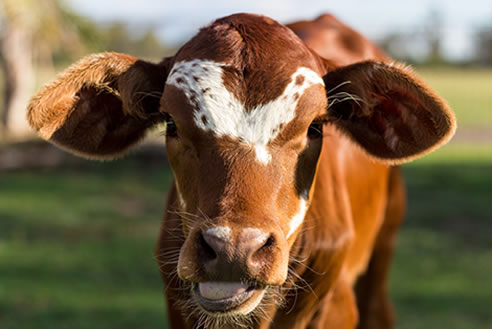Did you know that cows share 80% of their genes with humans? Or that they worry about the future and have excellent memories? Or that a cow can only produce milk when pregnant or after giving birth to a calf?
Origin
Approximately 10,000 years ago, humans domesticated cows from wild aurochs (bovines that were about twice the size of domestic cattle today). These aurochs ranged across Europe, North Africa, and most of Asia, and were eventually driven to extinction in the early 1600s due to hunting and loss of habitat. Christopher Columbus brought the first cows to America from Europe.
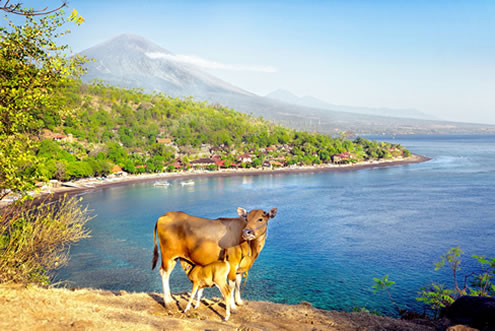 Natural Needs, Tendencies and Preferences
Natural Needs, Tendencies and Preferences
Cows create close family bonds and travel in herds. They eat mostly clover and some grass, and will avoid grazing in areas contaminated by the feces of other cattle.
Cows remain pregnant for about nine months until giving birth to a calf. A newborn calf can weigh between 55 and 100 pounds. Under normal conditions, calves remain with their mother until weaning anywhere from eight to 11 months. A commercial steer or bull calf usually gains between 70 and 80 pounds per month.
Cattle are intelligent creatures who can discriminate between familiar individuals including humans by appearance and colors. They are emotional, gregarious / friendly and prefer the company of others; if isolated even for short periods, they exhibit severe psychological stress symptoms. Their dominant sense is vision — they obtain approximately half of their information visually. They have a well-developed sense of taste, and their sense of hearing is more acute than that of other animals such as horses.
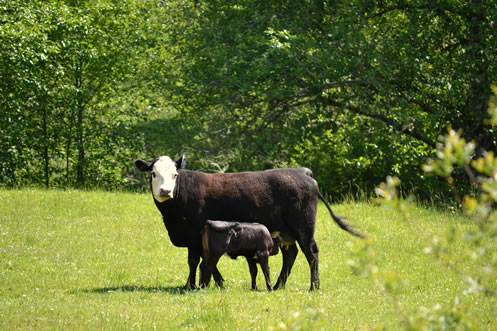 Cows experience many emotions such as fear, anxiety, happiness and pain, and they worry about the future. They form bonds and friendships, and can hold grudges against others. Cows have remarkable memories, can recall even human faces, have unique personalities and cognitive abilities, and are capable of learning from one another.
Cows experience many emotions such as fear, anxiety, happiness and pain, and they worry about the future. They form bonds and friendships, and can hold grudges against others. Cows have remarkable memories, can recall even human faces, have unique personalities and cognitive abilities, and are capable of learning from one another.
What’s Changed — A Cow’s Life Today
Thanks to the agricultural revolution, nomadic hunter-gatherers turned into farmers who chose to live in permanent settlements and domesticate certain animals like the cow.
Originally, people kept cattle for their meat and skin (leather), but then people began to make yogurt and cheese from a cow’s milk. By about 4000 BC, humans also used cattle to pull wagons and plows.
In North America, people ate wild cattle (buffalo / bison). When Europeans came to America in approximately 1600 AD, they brought their domesticated cattle with them. Two hundred years later, people also used cattle for plowing fields in North and South America. Across the American plains, people herded cows to replace the buffalo that Europeans had mostly eradicated by that time.
Since the early 1950s, there have been approximately 90 million cattle and calves in the U.S. year over year.
Dairy Cows
Since milk comes from pregnant cows, all dairy cows must give birth in order to begin producing milk. And farmers force them to produce a calf every year.
Like humans, the cow’s gestation period is nine months long, and so giving birth every twelve months is physically demanding. Dairy farmers also force the cows to give milk during seven months of their nine-month pregnancy.
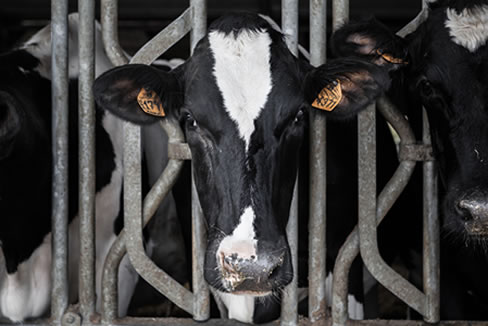 Also much like humans, cows in their natural environment and circumstances (without any human interference) will lactate only to produce milk for their newborn babies — and they will nurse their babies up to a year before weaning. However, dairy farmers forcibly impregnate cows and immediately take away their calves within 24 hours of birth. This is very traumatic for both the mother and calf, who will both frantically search and bellow for one another for days or even weeks.
Also much like humans, cows in their natural environment and circumstances (without any human interference) will lactate only to produce milk for their newborn babies — and they will nurse their babies up to a year before weaning. However, dairy farmers forcibly impregnate cows and immediately take away their calves within 24 hours of birth. This is very traumatic for both the mother and calf, who will both frantically search and bellow for one another for days or even weeks.
Female calves are allowed to live to become future machines for the dairy industry and are fed massive quantities of drugs to force unnaturally high milk production. With genetic manipulation and intensive production technologies, it is common for modern dairy cows to produce 100 pounds of milk a day. This is ten times more than a dairy cow would normally produce. The cows’ bodies are under constant stress and they are at risk for many health problems. And if all of that were not enough, dairy producers also cut off a cow’s tail depriving a cow of the only method she has to swish away flies and other insects from her body.
In a healthy environment, cows live in excess of 25 years. But on modern dairies, farmers slaughter them after just three or four years (once the cow’s milk production declines), and sell them for low-grade ground beef.
Male Calves = Veal
Male calves are not so lucky; farmers generally slaughter them at a young age to produce veal. In fact, the dairy industry created the veal industry to take advantage of an abundant supply of unwanted male calves. Producers keep veal calves imprisoned in crates so small that they are unable to turn around. This lack of exercise, combined with a diet deliberately deficient in iron and other essential nutrients, results in continuous diarrhea; the anemia is intentional in order to create the pale meat desired by restaurants. The abuse continues by keeping calves in darkness 22 hours out of every day to prevent restlessness. By the time the calves are slaughtered, they are often blind, crippled, extremely weak and sick. Producers must drag or carry most calves to their own death at only four months of age.
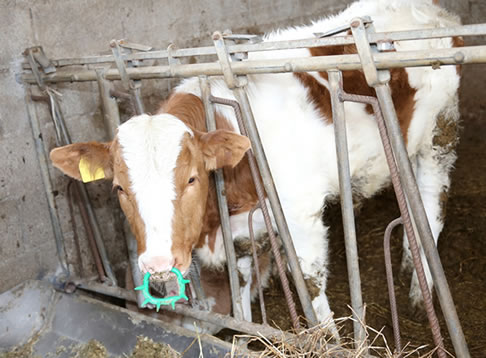
Cattle for Beef
Producers first subject cattle raised for beef to castration, dehorning, and branding without any anesthesia or other relief from the pain.
Accustomed to roaming unimpeded and unrestrained, range cattle are frightened and confused when humans come to round them up. Injuries often result as people corral and pack these terrified animals onto cattle trucks. The cattle also experience additional transportation and handling stress at stockyards and auctions. People goad them through a series of walkways and holding pens before selling them to the highest bidder. From the auction, buyers take the older cattle directly to slaughter, or to a feedlot.
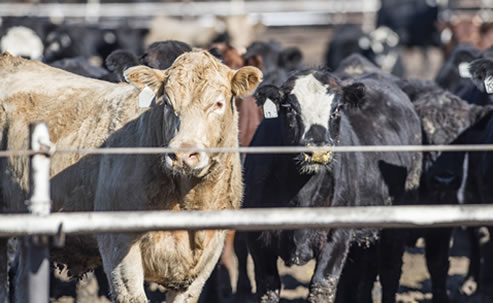
Most beef cattle spend the last few months of their lives at these feedlots, crowded by the thousand into dusty, manure laden holding pens without any access to pastures. The air is thick with harmful bacteria and particulate matter, and the animals are at a constant risk for respiratory disease. Producers routinely implant growth promoting hormones into the cattle, and feed them unnaturally rich diets designed to fatten them quickly and profitably. Because cattle are biologically suited to eat a grass-based, high fiber diet, their concentrated feedlot rations contribute to metabolic disorders.
Cause and Effect
According to the Food and Agriculture Organization, the livestock industry is responsible for 18% of greenhouse gas emissions. And cattle and other livestock emissions account for approximately 37% of all methane emissions.
So unless some drastic changes are made, the damage associated with raising animals as a food source may more than double by 2050. If producers do not manage manure properly, it can also cause water contamination, soil erosion, human and animal exposure to toxic chemicals, development of antibiotic resistant bacteria, and an increase in E. coli contamination.
Other issues resulting from the raising of livestock in such massive quantities include the loss of rainforests cleared for grazing and subsequent loss of wildlife, and the large consumption of valuable natural resources like water and grains.
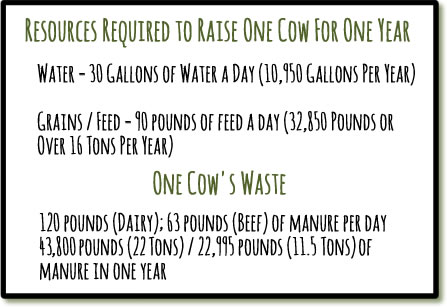 What Happens Next
What Happens Next
Again, Mother Earth simply cannot continue to produce the excessive amounts of resources required to raise just one pound of beef used as a human food source. We can no longer tolerate / justify and support the rainforest clearing for grazing, the emissions and pollution created by so many animals, or the requirements for water, land and feed.
Human beings also experience a wide range of medical issues as a result of dairy and beef consumption including: Osteoporosis (yes, the opposite of what we’ve been led to believe), various cancers, heart disease, diabetes, lactose intolerance and many others.
 With the abundance of cruelty-free dairy, beef and leather alternatives available on the market today, isn’t it time we all take a closer look at how our habits and traditions are impacting the future of our planet, our health, and our fellow inhabitants?
With the abundance of cruelty-free dairy, beef and leather alternatives available on the market today, isn’t it time we all take a closer look at how our habits and traditions are impacting the future of our planet, our health, and our fellow inhabitants?
Gory Details / Other Articles
http://www.farmsanctuary.org/learn/factory-farming/dairy/
http://www.peta.org/issues/animals-used-for-food/animals-used-food-factsheets/cows-milk-cruel-unhealthy-product/
http://www.peta.org/issues/animals-used-for-food/animals-used-food-factsheets/veal-byproduct-cruel-dairy-industry/
Compassionate clothing: http://www.peta.org/living/fashion/cruelty-free-clothing-guide/
Vegan Fashion Shopping List: http://www.farmsanctuary.org/vegan-fashion/
Wool, Leather and Down: http://www.farmsanctuary.org/learn/factory-farming/wool-leather-and-down/
Sources for this Article
Cattle; http://www.en.wikipedia.org
DNA Traces Cattle Back to a Small Herd Domesticated Around 10,500 Years Ago; http://www.ucl.ac.uk
Sentinence in Farm Animals: Cattle; http://www.think-differently-about-sheep.com
Farm Sanctuary
PETA

